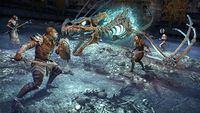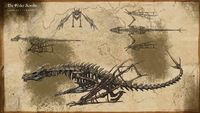Lore:Thurvokun
| Dragon Lord Thurvokun | |||
|---|---|---|---|
 Thurvokun's animated remains circa 2E 582 Thurvokun's animated remains circa 2E 582
|
|||
| Race | Dragon | Gender | Male |
| Born | Dawn Era |
||
| Died | 1st Era |
||
| Resided in | Skyrim Fang Lair |
||
| Appears in | ESO | ||
Contents
Thurvokun is a dragon whose name means "Overlord-Shadow" in the Dragon Language.
Thurvokun was among the dragons revered during the age of the Dragon Cult in Skyrim,[1] having a cult prior to the Dragon War.[2] As Dragon Lord, he chose his Dragon Priest Zaan when she was uncommonly young. It is said that her connection to Thurvokun was particularly strong, speculated that their connection was spiritual, magical, or perhaps merely political. Whatever the case, Zaan grew a rapid and robust attachment, which her followers took as a sign of great fortune and for around a decade, all was well.[3][4]
Thurvokun and his followers left central Skyrim for the remote mountain now known as Scalecaller Peak, believed to be due to a schism in dogma within the Dragon Cult.[5] Thurvokun then abandoned his worshipers, leaving Scalecaller behind and relocated to Fang Lair, for reasons unknown to all but perhaps Zaan herself. Following his departure, Zaan grew into a depressive state and her followers, while initially hoping Thurvokun would return,[6] had Zaan killed out of rage after many years of waiting.[7] They accredited Thurvokun's departure to Zaan's incompetence,[8] some also believed she had turned to worshiping Peryite in Thurvokun's absence.
The Dwarven citadel of Arkngthamz-Phng was a vast, secluded space in the Dragon's Teeth Mountains, rich with resources and life, as it was originally built by the Dwarves of Kragen. It is believed Thurvokun found it have more well-appointed accommodations than those chiseled out by Nords in the service of the Dragon Priesthood.[9] Legend has it that when Dragons and Dwemer still walked the land (at some point before 1E 700) Thurvokun drove the Kagren clan from their home of Arkngthamz-Phng, and took the Lair for himself.[10] When they clashed, the Dwarves unleashed their greatest works in defense of their home, but for all their invention they were no match for the raw power of the Dragon.[11] The bones of the thousands Thurvokun slaughtered in the city remained for ages, depicting a record of extinction and terror.[12] His roost came to be called "Fang Lair" by the locals,[11] a truncated adulteration of the original "Phng" paired with a suitably sinister descriptor for Thurvokun.[9] In the King Edward series, a golden dragon inhabiting Fang Lair had a large treasure trove of gold and absorbed the metal from it into his scales when lying on it. He encountered Moraelyn and allowed him to take an ebony sword after they removed a cursed tooth from his mouth, and called himself "Akatosh" when asked for his name.[13]
Thurvokun managed to live for millennia after the Dragon War because his reclusive hideaway kept him safe through that and all the Dragon hunts to come.[2] Though he outlived many of his kin that met their end at the hands of Reman's Dragonguard,[2][14] a group of adventurers found Fang Lair in the waning years of the First Era and traveled there to slay him.[2][15] Together, the warriors Ulfnor and Sabina Cedus, and mage Caluurion battled Thurvokun, with Ulfnor recalling that when he was still in the flesh he was a monster of godlike power. Together they managed to kill Thurvokun, but Ulfnor and Sabina were crushed by its death throes.[2] Caluurion attempted to capture his soul using a powerful soul trap, but because of its divine properties he was unable to obtain it. In an attempt to harness its power, he preserved many of Thurvokun's organs, and after his food supplies spoiled, turned to eating roast meat from the dragon's flesh (which he noted tasted like fowl). Caluurion remained in the lair as a lich and continued to try and harness the power of the dragon and the leftover aetherium crystals.[15][16]
By the Second Era the legend of Thurvokun's triumph over the Dwarves remained a popular tale, and the researcher Neramo paid a visit to the ruins to document them in a volume of Dwarven history, which was later discovered by the Blackmarrow necromancer Orryn the Black.[9][12] Upon learning of the necropolis he and his followers traveled there in 2E 582. He questioned Caluurion's lich about Thurvokun, thralling and resurrecting him and his companions.[12] As Thurvokun's soul could not be obtained and bound, the necromancers sought alternatives to resurrecting the dragon, developing a method of binding the soul of a similar animal (such as a mammoth or wamasu)[17] to Thurvokun's skeleton in order to control it.[18][19] A group of Undaunted warriors and trailblazer Yisareh came to the ruins and fought off the necromancers and undead, freeing Caluurion, Ulfnor, and Sabina, who then helped them defeat Orryn's minions. Orryn the Black made his last stand by resurrecting Thurvokun's skeleton and controlling it with another animal's soul, later transporting his own soul into the bones when he himself was killed, but was defeated in the end. Yisareh then purged Orryn's soul from Thurvokun's bones, leaving the remains as they were prior.[20] Fang Lair remained an abandoned site in the Third Era, with the tale of Thurvokun living on.[10]
Due to Caluurion's failure to capture Thurvokun's soul,[16][15] it can be assumed that the dragon has been permanently destroyed and cannot be raised again.[21] Although generally a dragon's soul persists after death unless consumed by a fellow dov, the link between a dragon's soul and its physical remains is far stronger than that of a mortal. The effects of prying a dragon's soul from its body through necromantic act are therefore the subject of fierce scholarly debate, with some speculating that Thurvokun's soul once severed may have simply dissolved over time or returned to join his father Akatosh.[22]
Gallery[edit]
See Also[edit]
- For game-specific information, see the Elder Scrolls Online
 article.
article.
References[edit]
- ^ Atlas of Dragons — Brother Mathnan
- ^ a b c d e Dialogue with Ulfnor
- ^ Meet the Character - Jorvuld Davaux — Professor Chamrond
- ^ The History of Zaan the Scalecaller — Jorvuld Davaux, Dragon Priest Historian
- ^ A Matter of Voice and Brass: Dragon Bones DLC Interview — Phrastus of Elinhir, Lady Cinnabar
- ^ A Brother's Plea — Hjarkborn
- ^ A Sister's Regret — Ruelde
- ^ A Sister's Retort — Ruelde
- ^ a b c Arkngthamz-Phng — Neramo
- ^ a b Events of Arena
- ^ a b Dialogue with Yisareh
- ^ a b c Journal of Orryn the Black — Orryn the Black
- ^ King Edward, Part VII — Anonymous
- ^ Paarthurnax's dialogue
- ^ a b c Dialogue with Caluurion
- ^ a b Caluurion's Notes — Caluurion
- ^ Reanimation Specimen Collection
- ^ Reanimation Experiment Findings
- ^ Death is No Laughing Matter
- ^ Casting the Bones quest in ESO
- ^ Events of Skyrim
- ^ Loremaster's Archive - Dragons in the Second Era — Camilla Calsivius


